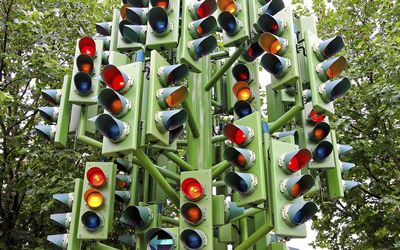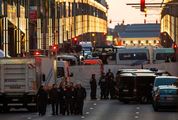Joburg to reduce time for traffic light repairs
by Shenaaz Jamal,
2016-03-18 06:28:58.0
EVER wondered why faulty traffic lights take so long to be repaired?
The answer lies in the fact that the Johannesburg Roads Agency (JRA) has only one technician for every 170 traffic lights in the city.
This, coupled with the fact that, on average, 81 robots are taken out of commission through accidents every month and a further 31 vandalised, means the technicians are in high demand.
In a bid to tackle this, the agency is going hi-tech to protect and respond to faulty traffic signals.
Speaking at a media briefing on traffic lights infrastructure in the city, head of the mobility and freight department Darryll Thomas said the JRA was in the process of employing more technicians.
But, in the meantime, a remote monitoring system valued at R3m has been installed for the city’s 2,135 traffic lights. This system will send a signal through a modem to the central control centre when a traffic light is out or malfunctioning.
"Our plan is to respond to traffic signal faults before it starts affecting the motorists. It (the system) gives us the opportunity to respond to faults, even after hours, much quicker," said Mr Thomas.
The JRA, on average, spends R380,000 a month on fixing vandalised traffic lights and R500,000 on repairing and replacing 81 traffic signals damaged due to vehicle accidents per month.
"Wet weather is no longer our primary cause of traffic signals going on the blink ," said Mpho Kau, acting MD at JRA.
The entity lost R14m since installing 200 back-up batteries on traffic lights in 2012. Another R14m is being spent to replace them but now the batteries will be prote,cted by casings called "the titanic".
The agency is also cutting the amount of copper in robots to reduce theft and is making use of CCTV cameras and sensors to alert officials. An infrastructure protection unit will be launched in May.
"We have got a dedicated team of JMPD officers who will be clamping down on traffic light vandals and arresting them," said Mr Thomas.

Internet of Things. Picture: ISTOCK
EVER wondered why faulty traffic lights take so long to be repaired?
The answer lies in the fact that the Johannesburg Roads Agency (JRA) has only one technician for every 170 traffic lights in the city.
This, coupled with the fact that, on average, 81 robots are taken out of commission through accidents every month and a further 31 vandalised, means the technicians are in high demand.
In a bid to tackle this, the agency is going hi-tech to protect and respond to faulty traffic signals.
Speaking at a media briefing on traffic lights infrastructure in the city, head of the mobility and freight department Darryll Thomas said the JRA was in the process of employing more technicians.
But, in the meantime, a remote monitoring system valued at R3m has been installed for the city’s 2,135 traffic lights. This system will send a signal through a modem to the central control centre when a traffic light is out or malfunctioning.
"Our plan is to respond to traffic signal faults before it starts affecting the motorists. It (the system) gives us the opportunity to respond to faults, even after hours, much quicker," said Mr Thomas.
The JRA, on average, spends R380,000 a month on fixing vandalised traffic lights and R500,000 on repairing and replacing 81 traffic signals damaged due to vehicle accidents per month.
"Wet weather is no longer our primary cause of traffic signals going on the blink ," said Mpho Kau, acting MD at JRA.
The entity lost R14m since installing 200 back-up batteries on traffic lights in 2012. Another R14m is being spent to replace them but now the batteries will be prote,cted by casings called "the titanic".
The agency is also cutting the amount of copper in robots to reduce theft and is making use of CCTV cameras and sensors to alert officials. An infrastructure protection unit will be launched in May.
"We have got a dedicated team of JMPD officers who will be clamping down on traffic light vandals and arresting them," said Mr Thomas.
























Change: -1.54%
Change: -1.49%
Change: -2.02%
Change: -0.73%
Change: -4.01%
Data supplied by Profile Data
Change: 0.10%
Change: -0.13%
Change: -1.54%
Change: 0.00%
Change: -0.39%
Data supplied by Profile Data
Change: 0.90%
Change: 0.28%
Change: 0.73%
Change: 0.89%
Change: 0.00%
Data supplied by Profile Data
Change: -1.96%
Change: -3.62%
Change: -3.91%
Change: -3.32%
Change: -1.95%
Data supplied by Profile Data